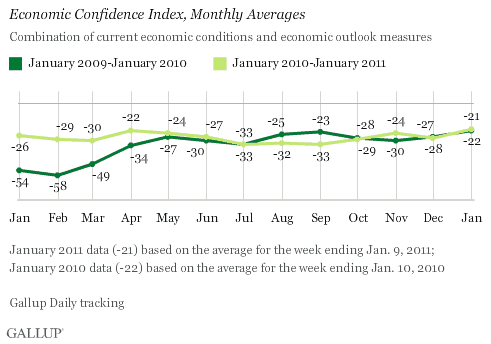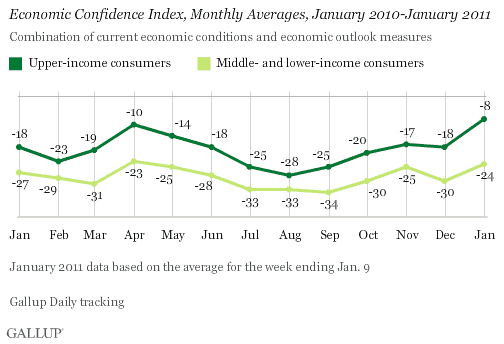PRINCETON, NJ -- Gallup's Economic Confidence Index improved to -21 during the week ending Jan. 9, 2011 -- considerably better than December's -28, but essentially the same as the -22 of the same week in 2010.

Gallup's Economic Confidence Index consists of two measures showing improvement: one gauging Americans' perceptions of current economic conditions and the other, their economic outlook. In Gallup Daily tracking from Jan. 3-9, 42% of Americans called current economic conditions "poor" -- slightly fewer than the 44% average rating of December. The 53% who in January said economic conditions are "getting worse" was somewhat better than the 59% of December.
Upper-Income Americans Remain More Confident Than Other Americans
Gallup's Economic Confidence Index among upper-income Americans (those making $90,000 or more annually) showed improvement in the first week of this month, averaging -8 -- compared with a -18 average during December and January 2010, and -17 in December 2009. Confidence among lower- and middle-income Americans (those making less than $90,000 per year) also showed improvement, at -24 in early January. Before that, optimism among this group followed a similar, if more pessimistic, trajectory compared with the upper-income group -- beginning 2010 at -27 and ending it at -30.

Implications
Gallup's Economic Confidence Index shows that consumer optimism improved in early January 2011 from December 2010. In turn, this suggests that the Reuters/University of Michigan Consumer Sentiment Index will also show improvement when the preliminary report is released on Friday -- although its relatively small sample size always presents a risk, particularly when its December estimate overstated consumer optimism compared with Gallup Daily tracking.
While upper-income consumers remained more optimistic than their middle- and lower-income counterparts throughout 2010, each group's optimism was virtually the same at the end of the year as it was at the beginning. During the first week of January 2011, however, consumer confidence increased across the board, with a proportionately greater improvement among upper-income consumers, to -8, than among middle- and lower-income consumers, to -24.
At least at this point, it appears that the extension of prior tax cuts plus the addition of some new Obama tax cuts on Social Security withholding may be having something of a positive, tax-cut-like effect on consumer confidence. A disproportionate increase in upper-income economic confidence is consistent with the surge in consumer spending Gallup measured during late December and is a positive not only for upper-income-oriented companies but the economy as a whole.
This sharp improvement in consumer confidence in early January 2011 is a hopeful sign for the future direction of the economy. On the other hand, economic confidence showed a similar sharp improvement during early January 2010 and then reverted back to prior levels. The course that economic confidence takes in the weeks ahead may provide a key early indication of whether the economy in 2011 will be better than that of 2010.
Gallup.com reports results from these indexes in daily, weekly, and monthly averages and in Gallup.com stories. Complete trend data are always available to view and export in the following charts:
Daily: Employment, Economic Confidence and Job Creation, Consumer Spending
Weekly: Employment, Economic Confidence, Job Creation, Consumer Spending
Read more about Gallup's economic measures.
View our economic release schedule.
Survey Methods
Results are based on telephone interviews conducted with 3,509 respondents as part of Gallup Daily tracking during the week ending Jan. 9, 2011, and with a monthly random sample of 12,937 adults for December 2010, aged 18 and older, living in all 50 U.S. states and the District of Columbia, selected using random-digit-dial sampling.
For results based on the total weekly sample of national adults, one can say with 95% confidence that the maximum margin of sampling error is ±3 percentage points. For results based on the December monthly sample, one can say with 95% confidence that the maximum margin of sampling error is ±1 percentage point.
Interviews are conducted with respondents on landline telephones and cellular phones, with interviews conducted in Spanish for respondents who are primarily Spanish-speaking. Each daily sample includes a minimum quota of 200 cell phone respondents and 800 landline respondents, with additional minimum quotas among landline respondents for gender within region. Landline respondents are chosen at random within each household on the basis of which member had the most recent birthday.
Samples are weighted by gender, age, race, Hispanic ethnicity, education, region, adults in the household, cell phone-only status, cell phone-mostly status, and phone lines. Demographic weighting targets are based on the March 2010 Current Population Survey figures for the aged 18 and older non-institutionalized population living in U.S. telephone households. All reported margins of sampling error include the computed design effects for weighting and sample design.
In addition to sampling error, question wording and practical difficulties in conducting surveys can introduce error or bias into the findings of public opinion polls.
For more details on Gallup's polling methodology, visit www.gallup.com.
